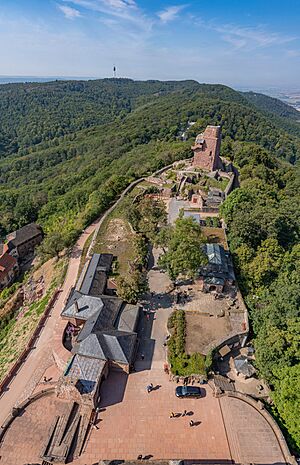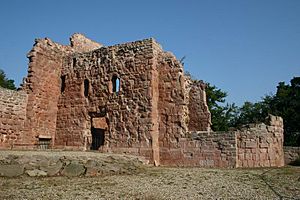Kyffhausen Castle facts for kids
The Imperial Castle of Kyffhausen is an old castle that is now mostly in ruins. It is located in the Kyffhäuser hills in Thuringia, a state in Germany. This castle is very old, likely built around the year 1000. It became very important during the 12th and 13th centuries under the Hohenstaufen emperors.
Today, the castle ruins are a popular place to visit. Many people come to see the castle and the Kyffhäuser Monument. This monument was built on the castle grounds between 1890 and 1896.
Contents
Where is Kyffhausen Castle?
The ruins of the Imperial Castle of Kyffhausen are on a hill called Kyffhäuserburgberg. This hill is about 440 meters (1,440 feet) high. The castle is located in the village area of Steinthaleben. This is about 3 kilometers (1.9 miles) northeast of a village called Rathsfeld.
The castle is part of the Kyffhäuserland municipality. This area is close to the town of Bad Frankenhausen. To the north of the castle, there is a flat area called the Goldene Aue. This area is about 160 meters (525 feet) lower than the castle. The castle grounds are also part of the Kyffhäuser Nature Park.
History of Kyffhausen Castle
People lived on this hill a very long time ago. Scientists have found tools from the Stone Age here. They also found pottery from the Bronze Age. This shows that people were living and building things on the hill thousands of years ago. In the 1930s, parts of an old fort from the Hallstatt era were found too.
Early Castle Building
The first castle on this high hill was probably built around the year 1000. It was likely built by Emperor Henry IV of the Salian dynasty. He wanted to protect his lands south of the Harz mountains. The castle was first mentioned in records in 1118. It was destroyed by Lothair of Supplinburg, a Saxon duke, after he defeated Emperor Henry V in a battle in 1115.
Rebuilding and Importance
The castle was rebuilt soon after its destruction. This work was finished when Emperor Frederick Barbarossa was in charge. He was a powerful ruler from the Hohenstaufen family. The rebuilt castle was made of bright red sandstone. It was very large and showed how powerful the emperor was in the region.
Decline of the Castle
After the Hohenstaufen family lost power, the castle became less important. In 1273, Rudolf of Habsburg became king. He gave the castle to the Counts of Beichlingen. Later, in 1375, they held the castle as loyal helpers of the Wettin family. The castle was then given to the Counts of Schwarzburg. By the 15th century, the castle was already known as a ruin.
The Legend of Barbarossa
In the late 1700s and 1800s, the castle ruins became a popular place to visit. Writers like Johann Wolfgang von Goethe enjoyed exploring the area. A famous legend grew around the castle. It said that Emperor Frederick Barbarossa was not dead but sleeping inside the mountain. He would wake up when Germany needed him most.
This legend became a symbol of German pride and unity. It was made popular by a poem written in 1817 by Friedrich Rückert. This idea led to the building of the Kyffhäuser Monument. It was built from 1890 onwards. In 1900, a group of veterans and soldiers even named their association the Kyffhäuserbund after this historic place.
Images for kids





